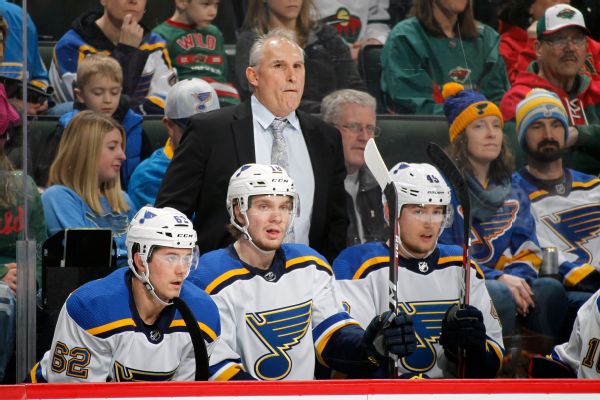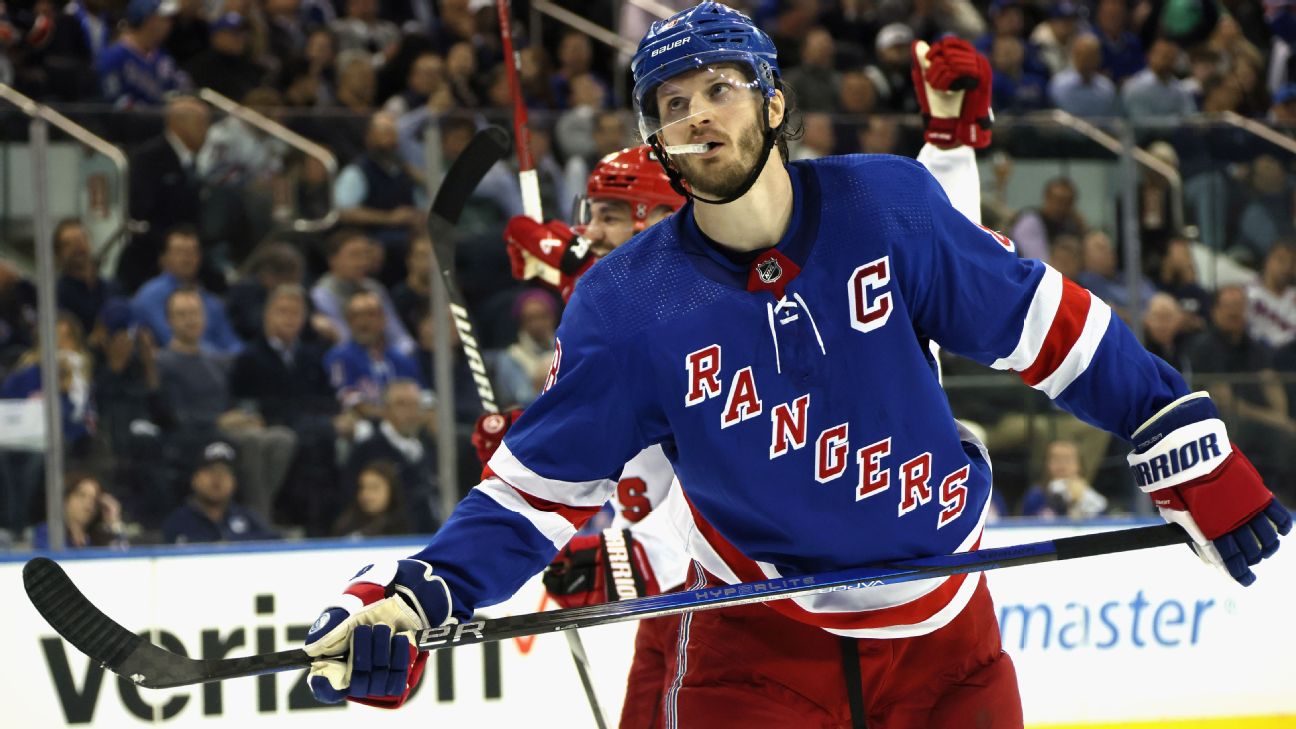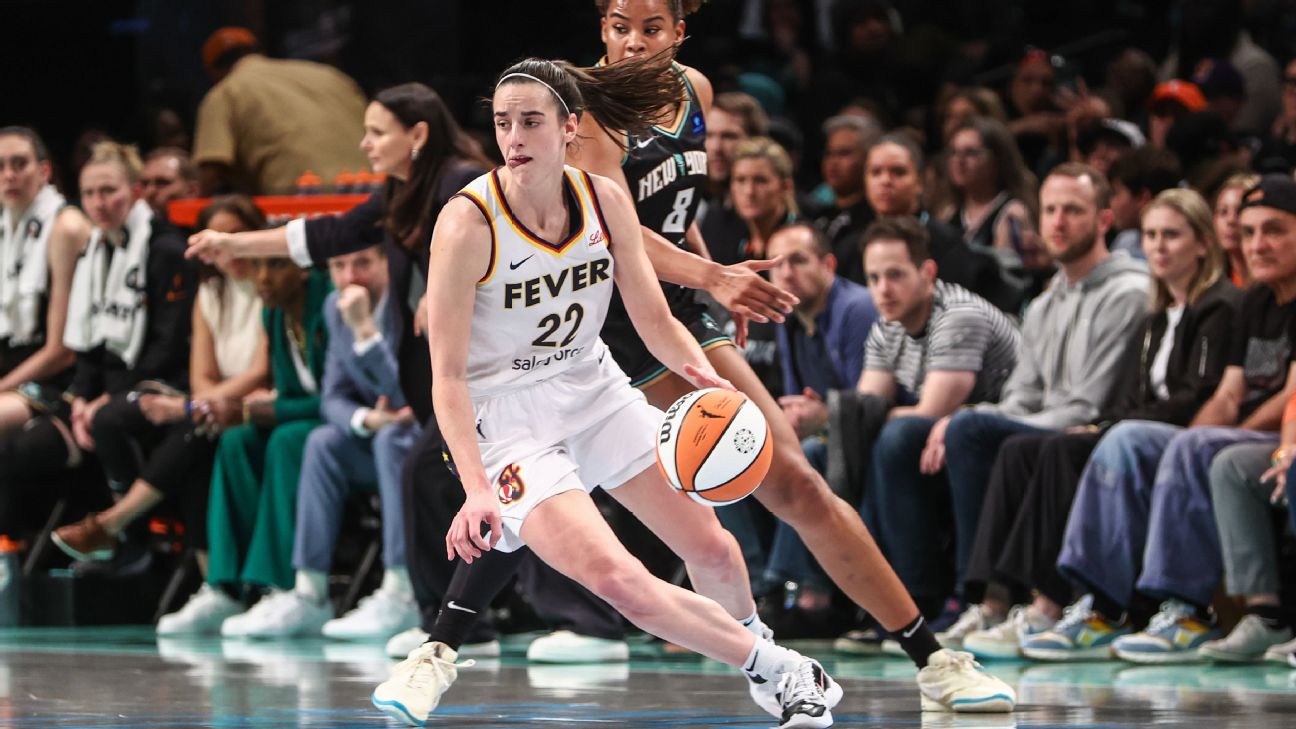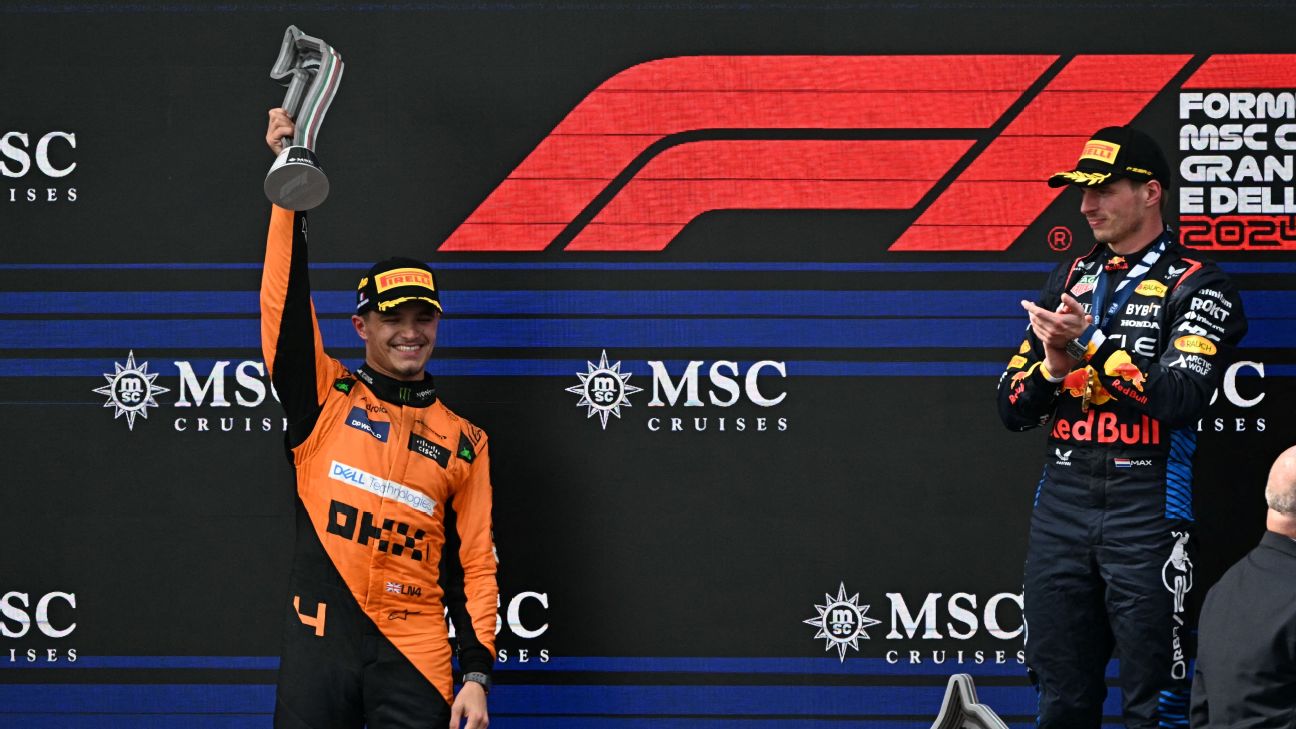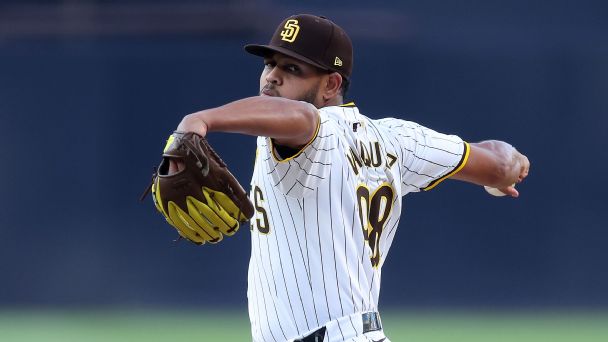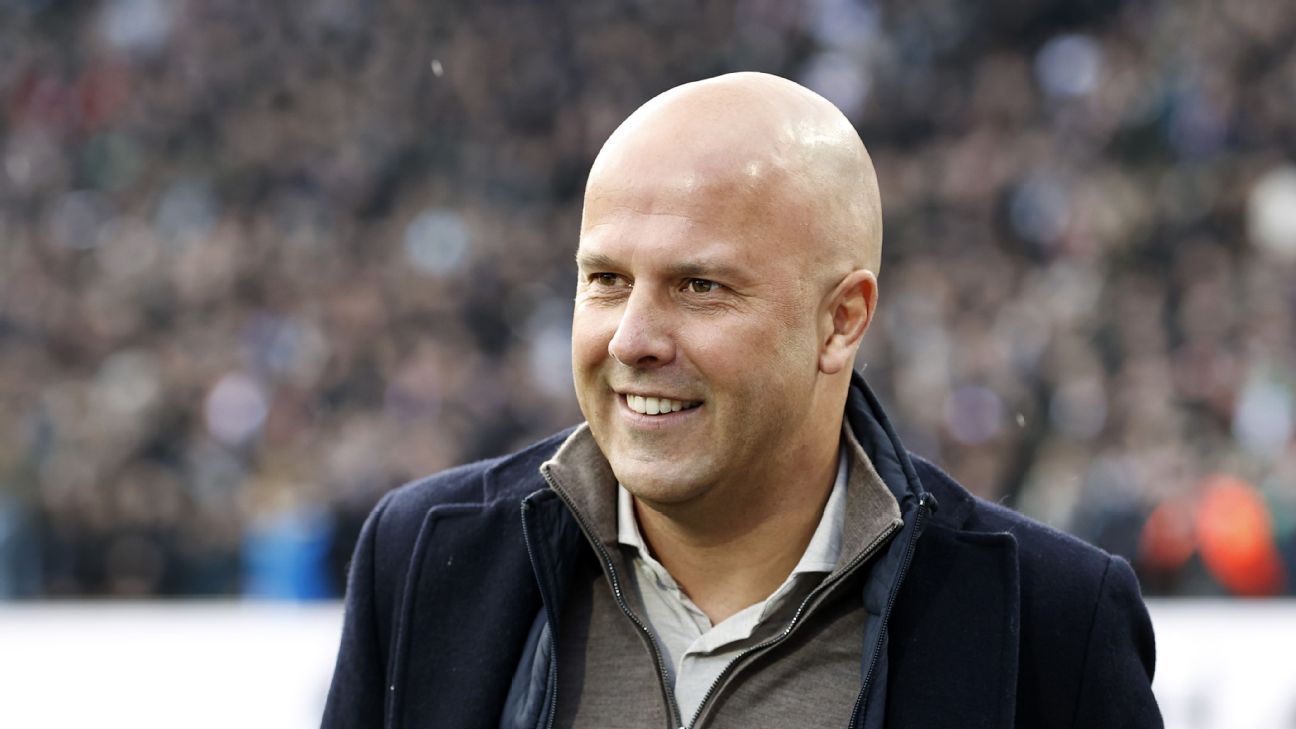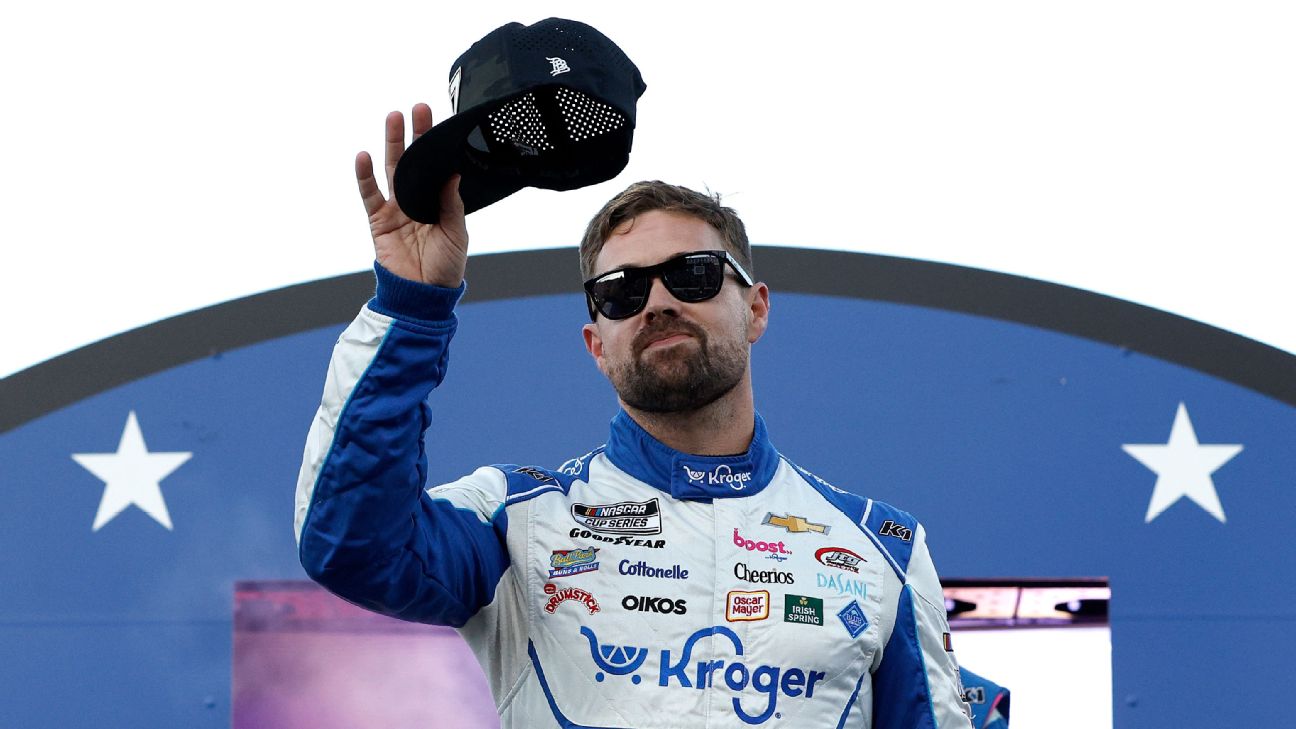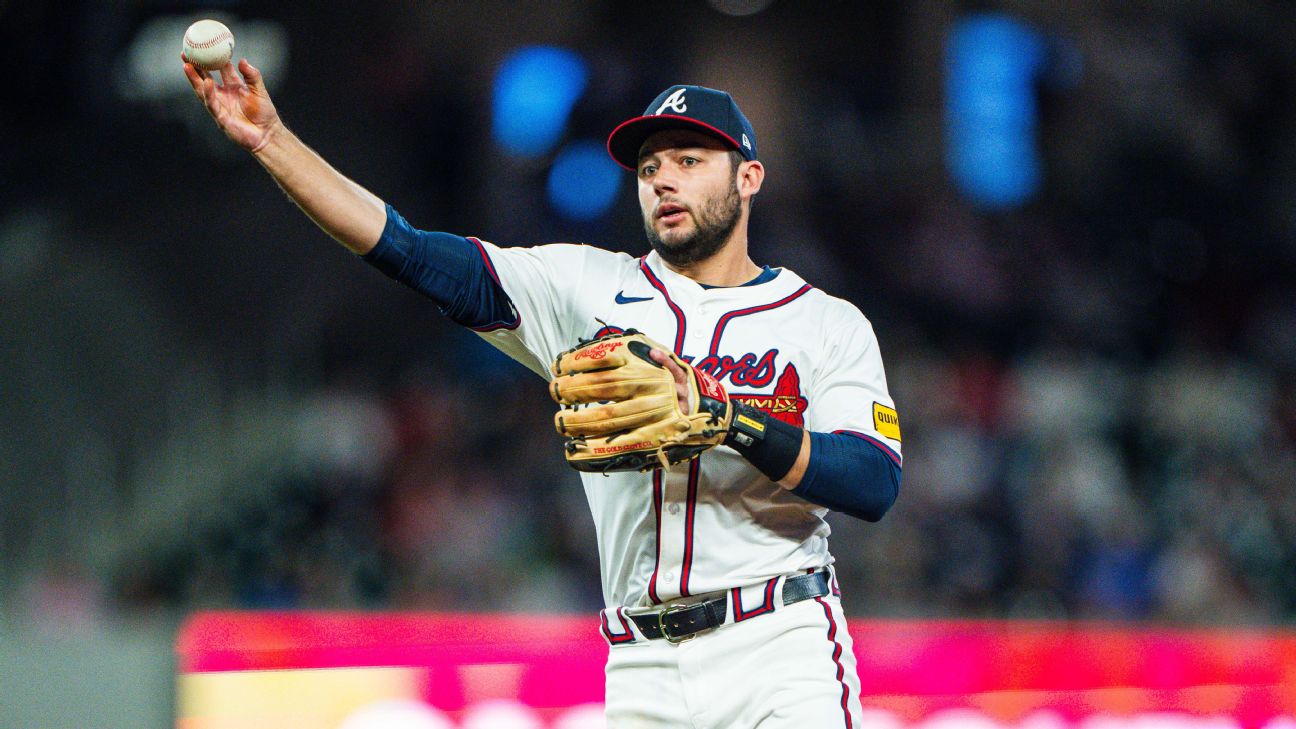![NHL Mock Draft [1500x844]](https://a.espncdn.com/photo/2024/0507/nhl-mock-draft_16x9.jpg)
College football post-spring Top 25 Power Rankings
The 2024 draft lottery is in the rearview mirror, and for the first time, it was a chalk lottery. The teams that were supposed to get the top two picks -- the San Jose Sharks and the Chicago Blackhawks -- received the top two picks.
Apart from some playoff seeding that could rearrange the draft order a little bit at the bottom, we know who is picking where. While my first mock draft required a bit of projecting for the draft order, now the mock drafts get a little more real as picks are locked in.
Let's jump in with the obvious choice at No. 1.
1. San Jose SharksMacklin Celebrini, F, Boston University (NCAA)
The San Jose Jr. Shark is going to be a San Jose Shark. Celebrini and his family are keeping their cards close to the vest, but make no mistake, the Celebrini family and Sharks are over the moon that the top prospect in this year's draft will be playing in California to start his career. Rick Celebrini spoke about the possibility of Macklin playing for the Sharks, and while there is no guarantee the Hobey Baker winner leaves school for the NHL, it feels more likely than not.
In Celebrini, the Sharks are getting a 200-foot player who seems destined for stardom. The combination of Celebrini and Will Smith up the middle will be a fun to watch for years to come. For his part, Celebrini has the ability to impact the game next season, and he would likely be the Sharks' best offensive threat. He drives play, understands defensive responsibilities, plays through contact and, most importantly, is a game-breaker.
Off the puck, on the puck, in transition and through offensive zone play, Celebrini can do it all. He's at his best when he can use his abilities in transition to be a dual threat, keeping opponents guessing and unable to cheat to the pass or shot. The Sharks are getting a franchise cornerstone in Celebrini, something that will surely speed the rebuild up by a year or two.
2. Chicago BlackhawksArtyom Levshunov, D, Michigan State University (NCAA)
Levshunov is a great talent, and the hulking right-handed defenseman has all the makings of an impactful defenceman at the NHL level.
The Blackhawks could use a high-end talent on the back end and right-handed defensemen who are excellent in transition are a rare commodity. Pairing him with Alex Vlasic or Kevin Korchinski for years to come must be a tantalizing proposition for GM Kyle Davidson.
Levshunov is capable of turning the game on its head through his physicality and his ability to drive offense. His ability to dictate the pace of the game from the back end is rare gift, and a hallmark of nearly all Cup contenders: Cale Makar, Luke Hughes, Victor Hedman and Adam Fox all come to mind as players of that ilk. While Levshunov doesn't have the offensive gifts of Makar, his ability to be physical and impose a game from that perspective is enticing given the physicality of the Western Conference. Levshunov is an agile skater that defends well, wins puck battles and has a ton of untapped upside on both sides of the puck.
A top-four defense group that includes Vlasic, Korchinski and Levshunov will go a long way toward making Chicago a better defensive team. One thing to watch for: if the Blackhawks can get assurances that Ivan Demidov will come over from Russia, they may draft him to be Connor Bedard's winger of the future.
3. Anaheim DucksIvan Demidov, F, SKA (MHL)
The Ducks are loaded up the middle with Leo Carlsson, Mason McTavish, Cutter Gauthier and Nathan Gaucher. It enables them to move Trevor Zegras to the wing, an area where they lack the same caliber of prospects.
Demidov is the second-best player in this draft, and the Ducks would be lucky to add him to their top six if Chicago passes. A dynamic offensive player who drives play, a rare ability for wingers, the Russian forward led the MHL in playoff scoring with 11 goals and 17 assists for 28 points in 17 games. That is impressive, but he also demonstrated that his offensive play style translates to the KHL. While there is no proof that it will translate to the NHL, it is an overwhelmingly positive sign that it translated to the senior league in Russia.
The MHL MVP would be a brilliant boost to the Ducks' prospect pool, and he is likely no more than two years from being an impactful top-six forward in the NHL lineup. With his ability to drive play and versatile offensive package, Demidov could look very nice on a line with Carlsson and Zegras, two players who read the game well and could match Demidov's creativity. The prize will be worth the wait for a Ducks team that is in the middle of a rebuild.
4. Columbus Blue JacketsCayden Lindstrom, F, Medicine Hat (WHL)
Every contender needs strength up the middle. The Blue Jackets got Adam Fantilli in 2023, and in 2024, they will add a second high-end pivot to their organization with Lindstrom.
He missed a chunk of the season through injury, but the blend of skating, soft hands and hockey sense at 6-foot-4 is too good a package to pass up for Columbus. Lindstrom gives the Blue Jackets a one-two punch up the middle that is surrounded by talented wingers such as Johnny Gaudreau, Kent Johnson and Patrik Laine. With a deep prospect pool on the blue line, Columbus can acquire a major piece of their rebuilding puzzle in Lindstrom without reaching.
He and Fantilli play a similar game, bring size and have the makings of a matchup nightmare for years to come. Lindstrom protects pucks, wins battles and drives the middle of ice to the dirty areas to create scoring chances for himself and his teammates. The Blue Jackets have been starved for high-end talent at the center position for years, something they can fix in the span of two drafts with Fantilli and Lindstrom. No need to overthink drafting a central, long-term pillar of the organization.
5. Montreal CanadiensTij Iginla, F, Kelowna (WHL)
In every draft year, there is a riser. Tij Iginla is that guy in 2024.
There is a distinct possibility that Montreal trades back a few spots, believing they can get Iginla closer to the 10th spot, but that's obviously a risk. Iginla is a gamer, which comes to the surprise of no one given his father Jarome's storied career and his sister Jade's excellent play for Canada.
Iginla was flat-out excellent in the back half of his WHL season, and a difference-maker at the U18 world championships in Finland. His tenacity, lightning-quick release and slick set of hands make for an enticing package.
Not only does Iginla have high-end offensive talent, but he's also shown capabilities as a strong defensive player too. Even if all his offensive talents don't translate to the NHL level, Iginla's ability to impact the game as a 200-foot player give him a higher floor than those of other offensive talents. If he hits his ceiling, he's a serious candidate to be a 70-point scoring winger who can play in tough matchups. Those are quite rare in today's NHL.
He's likely two seasons away from NHL action, but if Montreal is patient, Iginla can be a key part of Montreal's future up front. By all accounts, the Canadiens love him, and there is a lot to love about what the second-generation Iginla can bring to an NHL lineup.
6. UtahZayne Parekh, D, Saginaw (OHL)
Utah didn't win the lottery, but Zayne Parekh would be a quality addition to a prospect pool that already has Dmitri Simashev and other midlevel prospects on the blue line. I could also envision a scenario where Utah takes Anton Silayev here.
Parekh has the makings of an impactful offensive defenseman. The Utah prospect pool lacks two major pieces: a right-handed defenseman and an offensive defenseman. Parekh is both. With one draft selection, Utah could solidify their top-four defense group of the future and gain a power-play quarterback for years to come.
In Parekh, we're talking about a player who produced at a level that is extraordinarily rare at the OHL level. In addition, Parekh is more physically involved than some give him credit, and his physical play is arguably his most projectable attribute. He doesn't back away from contact, and he can get in trouble because he can sometimes be too physically involved. His play can be erratic, as is often the case with offensively elite blueliners, but teams are high on his skating, instincts and raw tools.
With proper development, Parekh is two years away from NHL minutes, and he could take a season or two before he finds his stride at the NHL level. If he hits his ceiling, there is a real chance he's in the Norris Trophy discussion for a good portion of his career.
7. Ottawa SenatorsSam Dickinson, D, London (OHL)
Given the new regime in Ottawa and their known desire to build from the blue line, Dickinson makes a lot of sense here, as a 6-3 defenseman who will use the full junior eligibility in the factory that is the London Knights. In Dickinson, the Senators get a raw talent whose blend of size, mobility and defensive play makes him an attractive addition.
Like many defensemen his age, his decision-making has some room for growth. Similar to Parekh, he put up incredible offensive numbers. The difference between the two is Parekh's offense carried into the playoffs, while Dickinson's defense took a step forward.
Dickinson's development has been a major talking point this season. It is no surprise London has produced another high-end player who has developed at breakneck speed; it is a pattern. During the regular season, Dickinson's offensive play developed to the point where many believed he could be a power-play quarterback at the NHL level, but wondered whether he would stick defensively. In the OHL playoffs, his production dipped significantly, but his defense has taken a step forward where scouts see a more well-rounded game that resembles a quality second-pairing player at the NHL level.
He'll need the full junior runway and likely a year at the AHL level to hone his craft, but the tools are there for a quality blue line in Canada's capital.
8. Seattle KrakenZeev Buium, D, Denver (NCAA)
The Seattle Kraken add the missing piece of their prospect pool, getting a blue-chip defender in Buium. There is a chance that Buium is gone here, but an impact defender will be available at this spot.
Buium played a major role in Denver's NCAA Championship this season, and scouts love his game. He played in big situations this season at the World Juniors and in the NCAA Frozen Four, and delivered. Many scouts call him a gamer, and Seattle needs that on the blue line to compliment Vince Dunn. He's a difference maker on both sides of the puck. An agile skater, he's in the middle of everything when he's on the ice. There hasn't been a single viewing where he hasn't been noticeable.
Seattle has time with young players like Matty Beniers, Shane Wright, Carson Rehkopf, Jagger Firkus and Eduard Sale all under the age of 22. Their window for serious contention is still a couple of years away, giving Buium time to develop and slot ahead of Caden Price and Lukas Dragicevic on the blue line. That collection of prospects getting the boost of an impactful defenseman in Buium gives the Kraken cornerstones at forward and on the blue line for years to come.
It would be entirely unsurprising to see Buium develop further under David Carle next season, win a directorate award at the World Juniors, be in the Hobey Baker conversation and sign with Seattle in the spring. He's that kind of talent.
9. Calgary FlamesAnton Silayev, D, Torpedo (KHL)
The run of defensemen continues, and Calgary adds a blue-chip blueliner to their pool. Regardless of which defenseman is available, it is believed that Calgary will take one here and would be right to do so. The plethora of defensemen at the top of the draft bodes well for Calgary given their need for a high-end prospect on the blue line.
Calgary has quite a few intriguing prospects up front but lacks a prospect who is projected to play top-four minutes. They get exactly that in Silayev.
Silayev stands 6-7 and, in a rare feat, is playing quality minutes in the KHL during his draft year. That bodes well for his NHL projection, and Silayev is closer to being NHL-ready than a few players ahead of him, but the Russian factor plays a role here; it's unclear when he actually will come over.
While he lacks flashy offense, Silayev is the mold of an impactful transition defenseman, with good skating and lateral mobility. He's very raw, and just scratching the surface of what he could be on both sides of the puck. With his size and skating, he's a high-floor, high-ceiling player. At worst, he's a third-pairing, penalty-killing machine in the style of Nikita Zadorov. If he hits, he is a top-pairing minute muncher that produces 35 points every season.
Calgary needs young defenseman, and should be thrilled to build around a player of Silayev's caliber.
10. New Jersey DevilsCole Eiserman, F, USNTDP
With the belief that Eiserman is going to be a goal-scoring winger at the NHL level, it makes a ton of sense for the Devils to select the NTDP product to pair with Jack Hughes, if they do not trade the pick.
A late August birthday makes Eiserman one of the youngest players in the draft, fresh off breaking Cole Caufield's goal-scoring record with the NTDP. His ability to create shots and release the puck with extreme accuracy is a coveted skill in the NHL. The idea of a top-six group that includes Hughes and Nico Hischier up the middle, with Jesper Bratt, Timo Meier and Cole Eiserman on the wings would excite the Devils and their fan base. Eiserman's goal-scoring ability is not a teachable asset. You have it, or you don't, and he has it. He's got all the makings of a 35- to 40-goal scorer, and could be more dangerous if he can consistently use his strength and make better decisions with the puck.
Scouts talk of an immaturity to his game, but that is teachable. A lot of talented players in his age group hang on to the puck a little longer than they should, and skate themselves into trouble. He'll need a season or two to develop pro habits, learn to use his strength to create more scoring chances and become a more well-rounded offensive player. He's got the one rare trait that every team needs: He puts the puck in the back of the net with consistency and authority.
The Devils are in a unique situation where they had a down year but are widely expected to be a playoff team in 2024-25. They can afford to take their time with Eiserman and give him all the tools he needs to develop into a scoring winger at the NHL level. Should they get him, he may be the guy that produces on his entry-level contract as New Jersey enters their contention window.
11. Buffalo SabresBerkly Catton, F, Spokane (WHL)
Count me in the "Buffalo Sabres should trade this pick" camp. They are chock full of prospects and young players at every position, and need someone who can be impactful immediately. Berkly Catton is not that, but giving a rebuilding team the chance to select him makes a ton of sense.
Catton is a well-rounded offensive player who possesses a slippery skating style, high-end release, and an ability to use space to make quality plays to his teammates. He understands how to draw defenders toward him and zip the puck to a teammate or on net for a scoring chance.
Should the Sabres keep the pick, Catton projects as a middle-six winger capable of making every one of his linemates better. Not only is Catton a well-rounded offensive player, he was a consistently effective penalty killer. That type of well-roundedness on both sides of the puck is translatable to the NHL level, and speaks volumes about his work rate and two-way abilities.
His small frame gives some scouts pause, but the ability to impact the game on both side of the puck gives Catton a better chance of being a middle-six player if he doesn't hit his offensive ceiling. There is a lot to like about Catton, and frankly, if he weren't 5-10, he'd be long gone by this spot.
12. Philadelphia FlyersCarter Yakemchuk, D, Calgary (WHL)
After a season where the Flyers overperformed expectations and nearly made the playoffs, they can add a quality prospect to their pool. Yakemchuk makes a lot of sense for the Flyers in this spot, adding to the prospect pool of Oliver Bonk and Emil Andrae on the back end. If Catton is available, I could see them taking him up front, with Konsta Helenius being another option given that they moved on from Cutter Gauthier.
In Yakemchuk, the Flyers are adding a quality right-handed defenseman that blends size, skating and a bomb of a shot. He understands how to use his strength, and when you think about the typical Philadelphia Flyer, he fits the bill. He's big, mean and unafraid to get in the middle of things, as evidenced by his 120 penalty minutes in the WHL this season.
The Flyers have skill in Cam York, Travis Sanheim and Jamie Drysdale, players who can move the puck but aren't particularly menacing. Yakemchuk balances out the finesse with some size, and for his part, can also be the finisher of one-timer opportunities. He's more likely to take penalty killing minutes than those three, and fits the bill of a player who can play in a second-pairing role.
His transition defense needs work, but his defensive zone posture, puck battles and physicality are qualities that NHL scouts really like. The Flyers would do well to develop his transition game to allow him to take advantage of his physical gifts and excellent shot.
13. Minnesota WildKonsta Helenius, F, Jukurit (Liiga)
The Wild are in an interesting position given their cap crunch and timeline with players on the roster.
Helenius is a player that could challenge for an NHL roster spot next season, at least according to former NHL player Olli Jokinen who coaches him in Finland. He is likely to be a middle-six center that drives play, without flash. The Wild could use some depth up the middle behind Joel Eriksson Ek and Marco Rossi, and adding Helenius to a young group of forwards that includes Marat Khusnutdinov, Matt Boldy, Liam Ohgren and Danila Yurov is enticing.
In Helenius, the Wild are getting a player with quality pro habits, good two-way play and better offensive capabilities than he gets credit for. Long term, he probably slides in to the third-line center role, giving the Wild a 1-2-3 of Eriksson Ek, Rossi and Helenius. A third-line play driver that can create offense and play a two-way role is hard to come by in today's NHL, and Minnesota could benefit from having Helenius' skill set in their lineup as soon as next season.
He'd fit like a glove in the Wild organization and learning his trade under the wing of Eriksson Ek is exactly what Minnesota hopes unlocks some of his offensive capabilities.
14. San Jose Sharks (via PIT)Adam Jiricek, D, Plzen (Czechia)
After adding Celebrini to a prospect pool that already has Will Smith, William Eklund, David Edstrom, Quentin Musty and company up front, the Sharks grab the younger brother of David Jiricek.
Had injuries not completely derailed his season, he is likely a top-10 pick in the draft, but scouts have concerns, and that has hurt his stock. He will be the Sharks' top prospect on the blue line, but if Jiricek turns into the player many believed he could be entering his draft year, he deserves to be mentioned in the same breath as some of the skilled forwards in San Jose's prospect pool and would be likely to play top-four minutes.
Adding Jiricek strengthens the blue-line group that already includes Henry Thrun, Mattias Havelid, Shakir Mukhamadullin and Luca Cagnoni.
The Sharks need skill on the back end, and Jiricek provides an injection of that. A right-handed defenseman with above-average skating and agility should make him a quality transition player on both sides of the puck. The Sharks have time with Jiricek, which he will need given a lost season to injury. The raw tools on both sides of the puck, combined with above-average hockey sense gives Jiricek a chance to be an impactful second-pairing guy if he can stay healthy.
15. Detroit Red WingsBeckett Sennecke, F, Oshawa (OHL)
Quite a few teams drafting in the early 20s were hoping that Sennecke would be available, but the late-season riser won't get there.
Sennecke really popped in the second half of the OHL season and in the playoffs, notching 22 points in 16 games, good for fourth in playoff scoring. Sennecke is the only draft eligible player who is top-five in OHL scoring, and is two years younger than everyone in the top 10 outside of Calum Ritchie and Easton Cowan. Truth be told, Sennecke may go higher, as a few teams have him in their top 10.
The Red Wings have a penchant for taking well-rounded forwards that are high-floor and low-ceiling. They need an injection of skill and potential top-line scoring. Sennecke fits the bill there, and while he is more likely to be a second-line scoring winger, his production since the turn of the calendar has vaulted him into a near 40% chance of becoming a top-line player.
Sennecke is someone that NHL teams have been keeping a close eye on; it feels like there are 17 scouts and three NHL GMs at every one of his games in the playoffs. He's exactly the type of skilled forward that Detroit needs to add to their prospect pool.
16. St. Louis BluesMichael Hage, F, Chicago (USHL)
The Blues' prospect pool is lacking a defenseman, and short of taking Aron Kiviharju or one of the top defenseman falling into their lap, the Blues will add another skilled prospect to their forward pool instead.
Hage has developed well in Chicago, becoming a dual-threat center who makes his teammates better whenever he's on the ice. He's a quality skater who attacks the middle, and is a consistently impactful player at the USHL level. In Hage, the Blues are getting a coveted combination of a natural center with good size, excellent work rate and a right-handed shot. There aren't many top-six, right-handed centers in the NHL, but the recent star turn of Wyatt Johnston comes to mind.
Hage may not be Wyatt Johnston, who likely fell in his draft class due to COVID-related reasons, but there is a scenario where he is a similar player to Johnston from the size to the handedness to the offensive capabilities and reliability.
Hage is scheduled to play at Michigan next season, a factory for quality centers. He'll have the opportunity to round out his game and develop for a couple of seasons before turning pro. Should the Blues take Hage, he will join a prospect pool that includes Dalibor Dvorsky, Otto Stenberg, Jimmy Snuggerud, Zachary Bolduc and Zach Dean up front. Most of those players are projected to be wingers the NHL level, making Hage the only right-handed center prospect in their pool.
Note that the following order of picks may change based on the results of the Stanley Cup playoffs.
17. Washington CapitalsIgor Chernyshov, F, Moscow (KHL)
18. New York IslandersLiam Greentree, F, Windsor (OHL)
19. Vegas Golden KnightsMichael Brandsegg-Nygard, F, Mora IK (Allsvenskan)
20. Chicago Blackhawks (via TB)Jett Luchanko, F, Guelph (OHL)
21. Los Angeles KingsRyder Ritchie, F, Prince Albert (WHL)
22. Nashville PredatorsSacha Boisvert, F, Muskegon (OHL)
23. Toronto Maple LeafsE.J. Emery, D, USNTDP
24. Anaheim Ducks (via EDM)Charlie Elick, D, Brandon (WHL)
25. Colorado AvalancheAron Kiviharju, D, HIFK (Liiga)
26. Ottawa Senators (via BOS)Andrew Basha, F, Medicine Hat (WHL)
27. Montreal Canadiens (via WPG)Maxim Masse, F, Chicoutimi (QMJHL)
28. Carolina HurricanesNikita Artamonov, F, Torpedo (KHL)
29. Calgary Flames (via VAN)Dean Letourneau, F, Saint Andrew's College (U18 AAA)
30. Philadelphia Flyers (via FLA)Trevor Connelly, F, Tri-City (USHL)
31. Dallas StarsTerik Parascak, D, Prince George (WHL)
32. New York RangersCole Beaudoin, F, Barrie (OHL)





